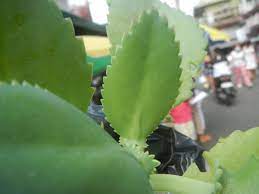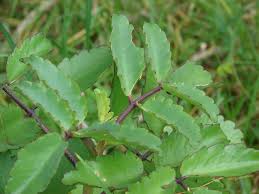While growing up in the south western part of Nigeria, the name, ewe abamoda, is a common thing we used to hear. We see it everywhere we go – in almost every household – but we didn’t fully understand what purpose it serves. If you’d asked any child what ewe abamoda (life plant) is used for, he or she will tell you its used to treat cough, and they will be right. However, that’s one of its many uses.
Ewe abamoda is popularly called Oda opue among the Igbos, Masallachi among the hausas, and has the English names; resurrection plant, miracle leaf, cathedral bells, sacred plant, and many more. It is also called Bryophyllum because of the peculiar plantlets it has along its leaves margins, a feature of plants in the Bryophyllum family. However, its scientific name is Kalanchoe pinnata. it is widely used for the treatment of kidney stones, hypertension, and headaches, among other illnesses, in traditional medicine.
This article focuses on helping you know the properties of ewe abamoda and how they influence its usefulness in traditional medicine. You will also get to know the different uses of the miracle leaf around the world. You’ll probably get a solution to one of the health issues plaguing you from this post.
[ninja_tables id=”44712″]
Properties of Ewe Abamoda
Miracle leaf is a thick and succulent leaf of the Kalanchoe. It is easily recognized by its characteristic red and serrated leaf margins, which readily root and establish itself as an independent plant when placed in a suitable environment. The leaves are green like most plants’ leaves but they are lighter in color and the serrated margins usually have red colors tainting the green.

The physical properties of the miracle leaf hold little importance when compared to the immense properties the leaves posses chemically. The chemical properties of the ewe abamoda is the reason behind its many usefulness.
The chemical properties of ewe abamoda, presented in the chemical constituents extracted from the leaves during research [mfn]https://www.sciencedirect.com/science/article/pii/S0102695X18305040[/mfn] include proteins, alkaloids, cardiotonic glycosides, flavonoids steroids, organic acids, sugars, vitamins, minerals, bufadienolide, saponins, tannins, carbohydrates, and esters.
Each of these chemical components has an effect on the human body. Some of them, such as steroids and flavonoids, are anti-inflammatory, and consequently help to reduce swelling and edema. The cardiotonic glycosides help to improve the function and efficiency of the cardiac organs, by increasing the rate of cardiac muscles contraction.
Proteins, vitamins, and minerals are important in providing nutrition to the body, aiding in metabolism, and functioning of different organs of the human body. Ewe abamoda can serve as a supplementary source of these nutrients.
However, bufadienolide is a chemical compound that is toxic and cause a number of cardiac problems, such as bradycardia, atrioventricular block, and even cardiac arrest. Therefore, miracle leaf can be a life saver, and at the same time, a killer.
Medicinal Uses and Health Benefits of Ewe Abamoda
From the chemical properties of ewe abamoda, there are a number of medicinal uses that these properties offer. Some of them are for simple home remedies while others can help address more serious health conditions. However, consult your doctor before you use ewe abamoda for any serious condition, such as issues that concern your kidney, heart, or liver.
Miracle leaf or ewe abamoda is used for the following medicinal purposes:
Treatment for Pain
Pains associated with the ears, eyes, headaches, and stomach aches are reported to be things of history when ewe abamoda is used to treat them. This medicinal use is probably due to the presence of phytochemicals such as alkaloids and flavonoids, which are known to be effective analgesics.
Diuretic Issues Treatment
Diuretic issues are health issues associated with the removal of salt from the body. This function is usually performed by the kidney but may be inadequate if the kidney is defective. An ineffective kidney causes edema, as a result of increased water retention in the body, which in turn, causes the blood pressure in the body to rise.
Ewe abamoda will help you urinate more, thereby reducing the water and salt content in the body.
Inflammation control
Inflammations as a result of infection – as in boils, reaction of the body to pain – as in arthritis, or retention of fluid in the body due to ineffective kidney functions, can all be brought under control due to the anti-inflammatory properties of ewe abamoda. The phytochemicals, steroids and flavonoids, help in this use.
Cure for bleeding diarrhea
Bloody diarrhea is a potentially serious condition that may arise due to infection in the gastrointestinal tract or as a result of injury in any part of the gastrointestinal tract. It is, therefore, important that you do not self-medicate when this condition arises.
However, ewe abamoda has been known to stop bloody diarrhea, otherwise called dysentery. It does this due to its antibacterial properties that treat infections of the gastrointestinal tract.
Treats cold and cough
Ewe abamoda helps to reduce the congestion in the lungs and eases breathing. Its antimicrobial properties help to combat the virus that causes flu and its anti-inflammatory properties help to reduce the inflammation of the sinuses, helping nasal fluids pass through the nose easily.
The combination of these properties helps to effectively treat congestion in the lungs, nose, and chest, and improves the quality of life.
Improves the Immune System
The human immune system needs to be constantly strengthened. Ewe abamoda contains vitamins and minerals that are important in the strengthening of the immune system, making it possible for the body to withstand and combat foreign materials.
Vitamin C and E, present in ewe abamoda is responsible for strengthening the immune system due to their antitoxic properties.
Other health benefits that can be derived from the use of ewe abamoda include improved and regular vaginal health and lubrication condition, treatment of diabetes, better sleep quality, and improved skin conditions.
Toxicity of Ewe Abamoda
Ewe abamoda is useful in many respects, including improvement of cardiac condition and health. However, the presence of bufadienolide glycoside in the extract of the leaves is a major concern as to the safety of its use. Although the leaf contains other cardiac glycosides that are beneficial, bufadienolide may cause lethal cardiac arrest, especially when taken in excess.
Therefore, consult a certified traditional medicine expert before you use the miracle leaf, so as to ascertain the right amount of its juice you should consume for your diagnosed condition.
Conclusion
Ewe abamoda goes by many names in different parts of the world. it is an important plant that is used to treat many health conditions due to the abundance of phytochemicals it possesses. However, some of these phytochemicals are dangerous, necessitating the use of ewe abamoda under the instruction of a certified traditional medicine expert.
To be safe, consult an expert with your diagnosis before you use ewe abamoda for any serious health condition.






2 Comments
How do I use ewe Abamoda for severe HEAD ACHE?.
Crush six ewe Abamoda leaves and apply to your forehead. The headaches we reduced.
Apply for three days.
How do. I use ewe Abamoda for severe HEAD ACHE?.